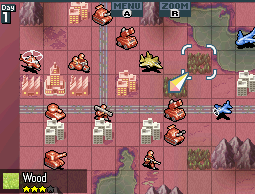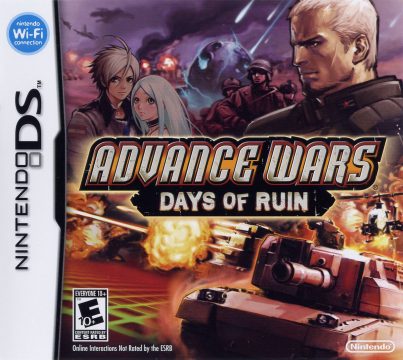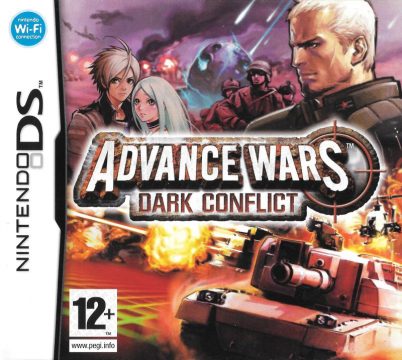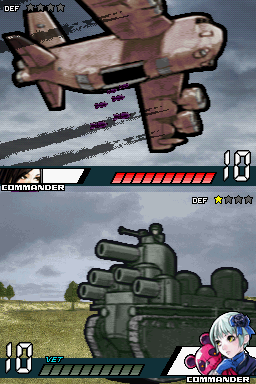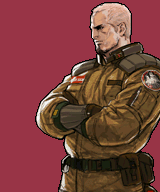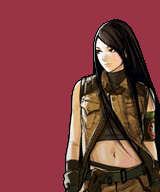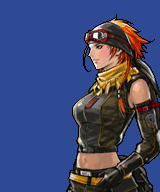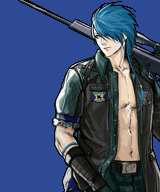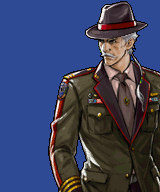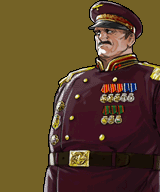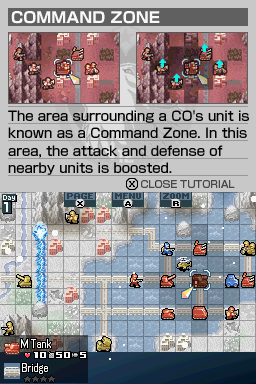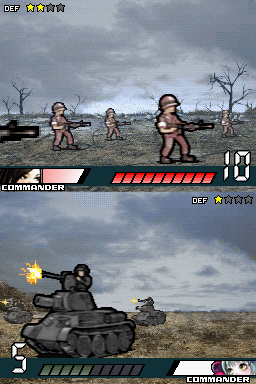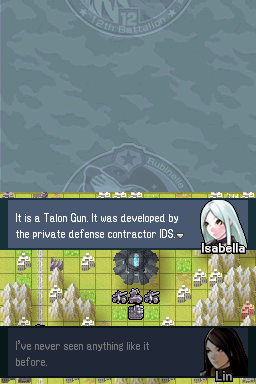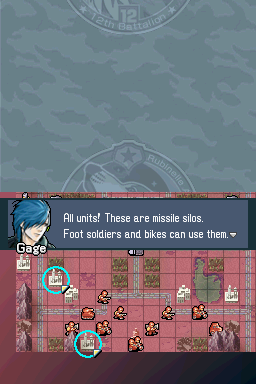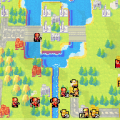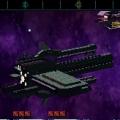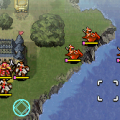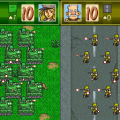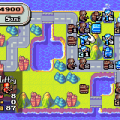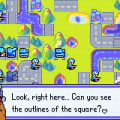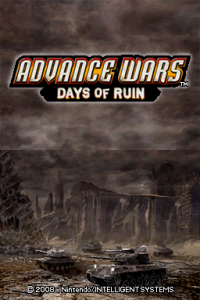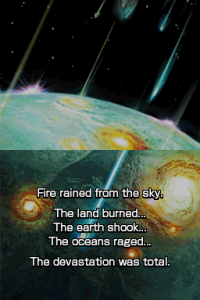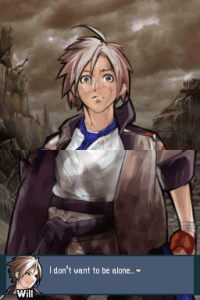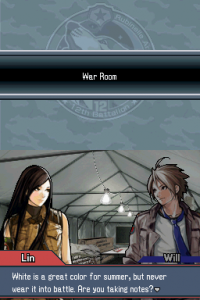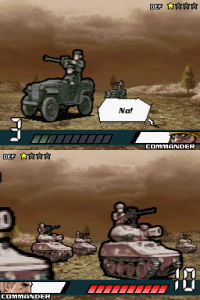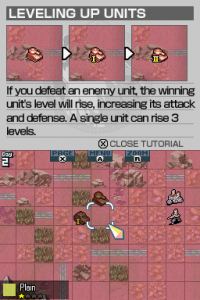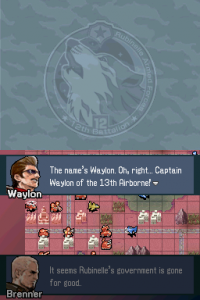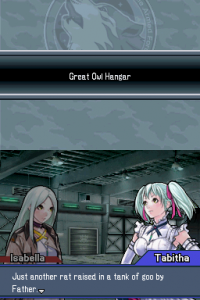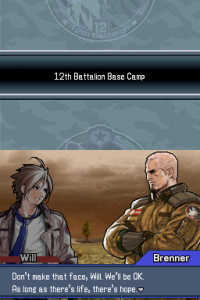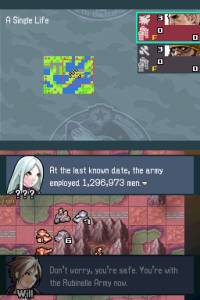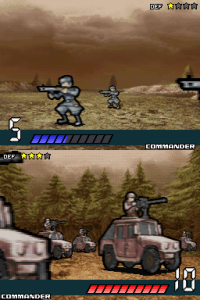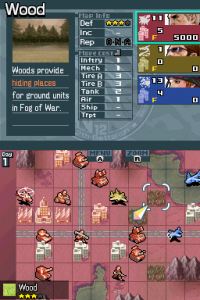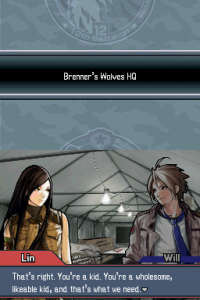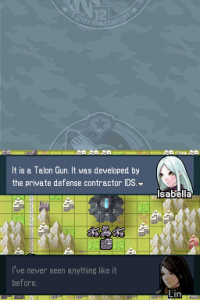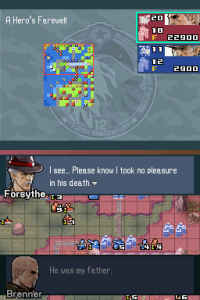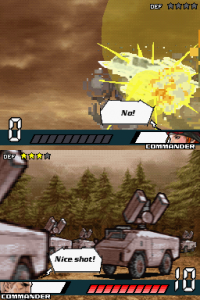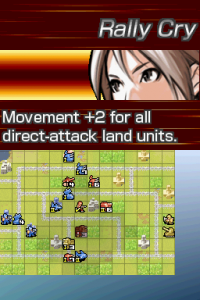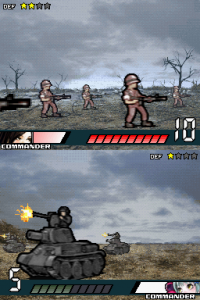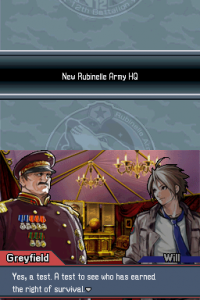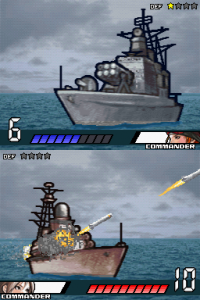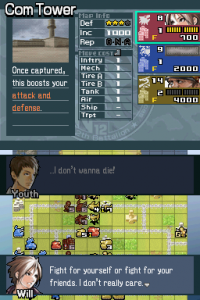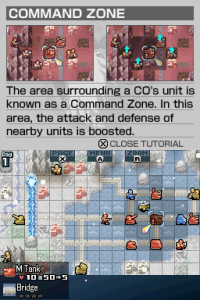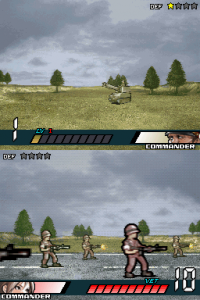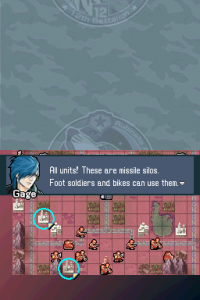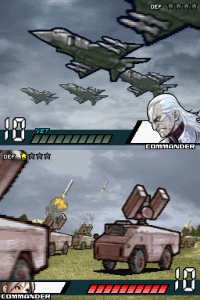Dual Strike, despite its best efforts, had some issues. It answered long-standing flaws with further issues, and provided superficialities and failures in equal measure. At this point the cracks were starting to show, and people wanted to see improvements. They wanted something different. They wanted a game that gave the series a fresh coat of sealant and paint. Intelligent Systems responded by providing precisely all of that. A fresh start, with tight mechanics, and solid gameplay. They delivered Advance Wars: Days of Run.
The result was contentious.
Days of Ruin is a striking departure from the previous incarnations of the series, doing away with the cartoony look and the goofy light-heartedness of the series. Instead, Days of Ruin is set in a post-apocalyptic world and deals with heavy themes, with a striking art-style provided by Hiroaki Hashimoto, known for his work on the King of Fighters series.
“Our world is destroyed. fire rained from the sky.
The land burned… The earth shook… The oceans raged…
The devastation was total. Dust covered the earth, blotting out all traces of the sun.
It seems impossible that anything could survive.
But amid the destruction, there is hope…”
After that tone-setting crawl of intro text, the player is introduced to a ruined world from the perspective of a young military cadet named Will. Upon digging himself out of the ruins of the academy after weeks from the fall of the meteorites, he looks out in terror at the idea of being alone. It isn’t long before someone arrives, but his hopes are dashed as the oncoming force are raiders that make it very clear, very quickly that they’re interested in what he has and nothing else. Before they can overtake Will and kill him, remnants of his nation’s army arrive and rout the raiders. Headed by the idealistic Brenner and the realistic Lin; the 12th Rubinelle Battalion, Brenner’s Wolves, make their way through the remains of the broken world in search of survivors, clinging to hope.
The narrative of Days of Ruin is a central component of the game, featuring a variety of characters that all see and respond to the dire situation they find themselves in very differently. While the main cast of characters are easy to categorize as ‘the good guys’ and ‘the bad guys’, many characters express surprising degrees of depth and third-dimensionality. Lin for example follows Brenner’s idealistic charge, and supports his cause, but finds herself disagreeing with his outlook and perspective rather regularly. When it comes time to give orders of her own, she finds herself contending with the fact that her pragmatism scarcely does her intentions right. Yet despite the dire situations and circumstances, the game never drifts into bleakness or senselessness. The tone is carried with a maturity, and doesn’t delve into edgy triteness. The cast is strong and carries the narrative well in the face of the game having a distinctly longer script than any entry prior.
The 12th Battalion, “Brenner’s Wolves”
Will
Moreso than the “new guys” of prior entries, Will is the main character of Days of Ruin. While a bit naïve, over the course of the game his perceptions and ideals are challenged, as well as his capability to lead. True to his name, Will embodies hope and the drive to carry on. Early on, returning units are introduced by Will citing his military academy studies. This presents Will as the most intelligent and mature of the ‘new guy’ COs. Will’s CO zone is moderately sized, and enhances the damage of his directs. Will’s Power provides an additional burst of mobility to his directs.
Brenner
The leader of the 12th Battalion, Brenner is a seasoned captain and well respected by his peers and command. While well acquainted with the ugly side of humanity, Brenner manages to be an idealist who never stops dreaming of a better tomorrow and vows to protect everyone that he can. His CO zone is large, and bolsters the defence of his units greatly. Brenner’s Power restores the health of all of his units.
Lin
Second in command to Brenner is Lieutenant Lin, the 12th Battalion’s intelligence and tactical lead. Lin is a realist and pragmatist who respectfully disagrees with her captain’s lofty views and ideals, while they don’t often agree on things, she firmly believes in Brenner’s cause and her loyalty to him is absolute. Sharp as a whip, Lin is always attentive to detail and has a very dry sense of humor. Lin’s CO zone is small, but provides a high damage bonus to all ground units. Her Power extends the vision of her ground units, and allows them to see hidden units.
Isabella
A mysterious girl who Will finds while on recon for survivors. She has no memory, but seems bizarrely knowledgeable about things that no civilian should be. Shy and quiet, Isabella struggles to get along with most people and finds it difficult to be close with anyone that isn’t Will. While she doesn’t participate in combat during the campaign, Isabella is available for use in Versus. Isabella’s CO zone is moderate and provides a boost to all unit’s attack and defense. Her Power grants enhanced mobility to all units, and her indirects enjoy greatly expanded range. Isabella’s theme is also hilariously dissonant from the musical tone of the rest of the game, being very cute and cheery.
Lazuria
Tasha
Driven by anger, Tasha bears a strong grudge against the nation of Rubinelle due to the extensive conflict between nations resulting in the death of her brother. When circumstances give her cause to rethink her hatred, she reveals herself to be a passionate and caring individual. Tasha is an air specialist with a small CO zone, a defense boost and sizable damage boost for air units. Her Power raises the mobility of her air units.
Gage
While Tasha is aggressive and driven by passions and personal matters, her counterpart Gage is cold, distant and calculating. Never driven by anything but practicality and what he perceives as being an ideal soldier, Gage is willing to do necessary things to achieve a goal with which others would find moral quandary. His CO zone is moderate, and it raises the damage and defense of his indirects, and his naval units. His Power extends the range of his indirects significantly.
Forsythe
An old soldier revered and respected by friend and foe alike, Forsythe came out of retirement to fight for his country one last time when the meteors struck. Well spoken and honourable, Forsythe is a model commander that those in his command look up to. Forsythe is different from the other COs in that he doesn’t have a Power and his CO zone does not expand. Instead it remains at a constant maximum size, and provides a respectable attack and defense bonus to all of his units over a wide area.
New Rubinelle
Waylon
An obnoxious man who always has a shit-eating grin upon his face, Waylon is a self-serving pilot of Rubinelle who finds his personal interests clash heavily with the 12th Battalion’s ideals. Waylon’s an oddity, with a moderate CO Zone that raises the defense of air units impressively and their attack respectively. His Power that raises that defense to amazing heights. Air units are not known for their durability, so an entirely defensive application leads to interesting opportunities with Waylon. Possessor of the best musical theme in the game.
Greyfield
Egomaniac without compare, Greyfield is the self-appointed head of the New Rubinelle Army. Loud, self-aggrandizing, ego-centric and quick to declare that any who disagree with him deserve to be hanged, Greyfield is a constant thorn in the side of the 12th Battalion. To borrow a description from an internet personality, ‘Greyfield looks like every dictator in history at the same time.’ Sporting a large CO zone, Greyfield provides a modest boost to damage and a sizable boost to defense for Naval units, Sea Planes, and Helicopters. His Power resupplies resources for all units, including the Rig’s materials.
IDS (Intelligent Defense Systems)
Penny
A child with a stuffed bear, a large degree of whimsy and a non-zero degree of unhinged insanity, Penny is the first member of IDS to test the 12th Battalion. Penny’s motivations for leading an army are simple and childish, doing so either because she’s been told or because explosions go BOOM. While she has a large CO zone, it does not convey any particular bonuses and instead her entire army enjoys not having to pay attention to the effects of weather. Penny’s Power causes random weather to be enforced for several days.
Tabitha
Sadistic and cruel, the 12th Battalion most frequently face the eldest of the IDS siblings, Tabitha. Tabitha delights in the suffering of others and cares little for any other than herself, though she never actually physically harms anyone off of the battlefield. True to her selfish nature, Tabitha’s CO zone encompasses herself and no one else unless expanded. To compensate for this, Tabitha herself boasts a tremendous attack and defense boost that makes dealing with her unit very dangerous and difficult. Her Power calls in an air strike, reminiscent of Sturm’s meteor.
Caulder
Fascinating.
On a mechanical level, it’s very easy to make the statement that Days of Ruin is the best entry in the entire franchise when it comes to unit balance. The entire unit list has been overhauled; with over-priced units receiving discounts, underperforming units receiving adjustments, and new units that fill useful roles. While the ever-lacking Naval gameplay isn’t quite solved, the game comes mighty close. Several previously worthless units have been discounted and had their performance enhanced, and the addition of the new Gunboat unit provides a much needed ‘tank-like’ analogue upon the sea. Harkening back to Super Famicom Wars, units now promote when successfully defeating an opposing unit, with ranks First, Second, and Veteran. A Veteran receives a worthy bonus to both offense and defense, making their value quite distinct. Preservation of Veteran units, and the prevention of allowing the opponent any are important aspects of play.
In the CO realm, gone are Dual Strikes, Tags, and Super CO powers. The entire CO and Power systems have been overhauled. A CO’s units no longer globally benefit from constant adjustments. Instead, COs can pay half the price of a unit to personally board it themselves. This performs two distinct functions. First, the unit instantly becomes a Veteran. Secondly, the CO on board will project a radius of influence. Allied units within this radius will enjoy the CO’s unique characteristics as well as a passive basic boost to their stats, an aspect similar to Masaya’s 1990s strategy-RPG series Langrisser. Further, units within the radius (including the CO unit) that make engagements with opposing units will charge the CO’s meter. At half-charge, the radius expands. At full-charge it expands yet again, and allows the CO to use their CO Power. CO Powers convey the Radius Bonus to all of the CO’s units on the entire map, and perform a unique effect, just like in prior entries. Upon conclusion, the meter and Radius reset. This causes the player to make strategic and tactical decisions. On the one hand, most CO Powers are highly potent and covering the entire map with one’s bonus is quite mighty indeed. On the other hand, it may well be more prudent to continue to take advantage of the larger radius in order to make the army’s efforts consistently more effective where they count most.
Compared to Dual Strike, the offerings of the game are distinctly leaner. There’s no alternative gameplay modes, and any out-of-campaign progression doesn’t exist at all. There’s not even the long-standing Advance Campaign option which had been a staple since Advance Wars, though the main campaign is already a step up compared to prior entries in challenge. The positive to this is that nothing is gated behind any arbitrary barriers, and thus there’s no content padding beyond just playing the game itself. That being said, for those who appreciate the offerings of the War Room in prior entries, there are optional maps unlocked by making progress through the campaign that functionally serve this purpose, though these are tests of skill and must be played without a CO.
The music of Days of Ruin is outstanding, featuring more situational themes as the narrative plays out than its predecessors, and character themes that continue the tradition of being expressions of the characters while all being very solid. There’s not a dull theme among the COs, even the one that is hilariously out of place among its peers yet entirely fitting for its character. All of the CO themes push the hardware’s sound capabilities to their limits. Visually, the art style is striking.
Characters look reasonably realistic, but not to an unpleasant degree. There’s a mature graphic novel look to everyone, and even with the fairly darkly-toned designs, each member of the cast pops in their own way. Unit icons have undergone some redesigns, and the game even features a zoom-in function that presents larger and more detailed unit icons which look very good. In battle is the one faltering point: reminiscent of motion comics, utilizing thick outlines and standing out starkly against the backdrop despite dull colors; the animation in battles is unfortunately rather limited and not quite as enjoyable to watch.
One of the more understated improvements to Days of Ruin is the adjustments it makes to terrain, changing attributes that have been consistent since as early as Famicom Wars. Terrain is far more varied, providing differing mobility penalties, defensive bonuses and many, many more terrain types that provide cover in Fog of War, or even extra vision. This provides for far more interesting maps, especially in the Naval sector which previously only had Shoals and Reefs to consider. Mist provides cover and light defense, while rough seas will provide moderate defense and slow ships down.
Another solution to a long-standing problem comes with a change to the APC unit. Now called the Rig, in addition to transporting foot soldiers and resupplying units, the Rig can now also construct Temporary Airfields and Seaports with the former being on any plains tile and the latter any shoal. These additions act the same as their more permanent counterparts with the exception that they can’t actually deploy anything. This allows air and naval units to come back and repair without preventing the construction of new units, or needing to completely abandon the frontlines to do so.
Dual Strike was released early in the DS’ life cycle, and wasn’t able to take advantage of the handheld’s capability to connect to the internet via Nintendo Wi-Fi. Days of Ruin on the other hand took full advantage of this. Capable of connecting to friends and playing matches, trading custom maps, and even playing pick-up-games against random players, Days of Ruin served its online purposes very well. There were two major limitations, however. The first being that three-or-more player games weren’t available, as the director felt that was a bit too much to ask of players in the hotseat. The second was that pick-up games could only use pre-made maps, which carried the long-standing complication of not really being balanced, and thus being a disservice to players of equivalent skill.
The production of Days of Ruin is a curiosity. Usually the Japanese version of the script would be the base that was adapted for other territories. This time around the decision was made to provide what amounted to CliffsNotes to the regional offices, and have them sort out the script themselves with no intercommunication between each other. This results in highly differing dialogue and even names between territories. While having different names in different regions isn’t anything new for the series, the degree present in Days of Ruin can cause confusion when comparing narrative points across versions.
Despite all of the improvements to the writing, the formula, and the gameplay; Days of Ruin, while critically well received, did not resonate with some players. Some found the shift in tone, both writing and visually, was too much of a departure from previous games. Further, those attached to the old cast were put off by their non-inclusion. It is most unfortunate that the strongest entry in the series that got the most things right failed to live up to its potential on account of shallow perceptions and callous disregard.
The entire effort backfired for Intelligent Systems, who had made their design decisions with western audiences in mind, particularly since the series was far more popular there than at home. In something of a haunting pattern, the Japanese version did not see release until well after the North American, European and Australian releases occurred, and not for typical release either. It was only available five years later as a Platinum Level Reward for Japanese members of Club Nintendo. While sales were decent in the West, the continued underperformance of the series left Intelligent Systems and Nintendo to put the series on mothballs.
